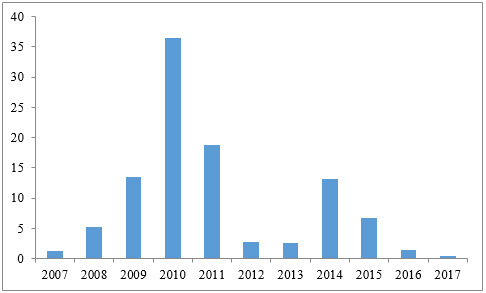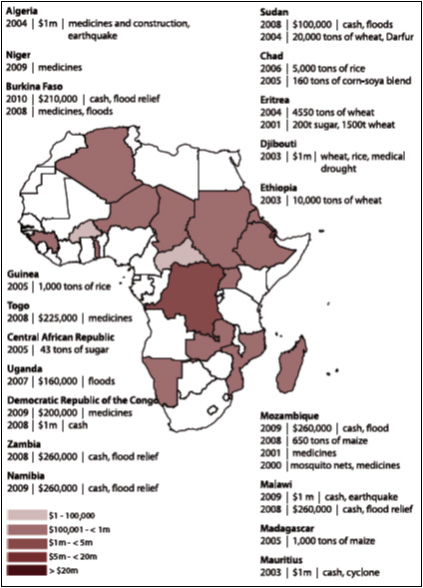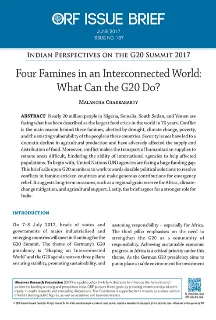Introduction
On 7–8 July 2017, heads of states and governments of major industrialised and emerging countries will meet in Hamburg for the G20 Summit. The theme of Germany’s G20 presidency is “Shaping an Interconnected World” and the G20 agenda rests on three pillars: ensuring stability, promoting sustainability, and assuming responsibility—especially for Africa. The third pillar emphasises on the need to strengthen the G20 as a community of responsibility. Achieving sustainable economic progress in Africa is a critical priority under this theme. As the German G20 presidency aims to put in place a stable environment for investment in Africa, the spectre of famine haunts millions of people in Africa and the Arab Peninsula. Nearly 20 million people in Nigeria, Somalia, South Sudan, and Yemen are facing what has been described as the largest food crisis in the world in 70 years. An additional 10 million people will be similarly threatened by famine if the international community fails to take adequate and timely action.
Famine: Definition, causes
The UN and food organisations define ‘famine’ as a situation when at least 20 percent of the households in a country face extreme food shortages, more than 30 percent of the children under age five suffer from acute malnutrition, and mortality rates are two or more deaths per 10,000 persons every day. Other symptoms include widespread destitution, outbreak of diseases, social collapse, and large-scale displacement.
In today’s era of a supposedly ‘interconnected’ world, what explains famines? There is a common misconception that lack of resources is the main driver of food insecurity. While droughts are often the trigger, famines are essentially created by human action (or inaction). In Jean Dreze’s words, “War is one of the last bastions of famine in the contemporary world. Almost every famine in the last thirty years or so has been connected with armed conflict of one sort or another. The connection is particularly evident in sub-Saharan Africa, where conflict-related famines have struck country after country – Angola, Ethiopia, Kenya, Mozambique, Nigeria, Somalia, Sudan, Uganda, to name a few.” [1] According to Dreze, famines in the 20th century occurred in India, China, Brazil, and Bangladesh even in the absence of armed conflict because public-assistance systems (national and international) were poorly developed at those junctures. However, in the modern world, it is possible to prevent famines quite easily in peace time because of the massive improvements in transportation and infrastructure. In other words, despite the role of natural disasters, modern famines are, essentially, man-made.
In the current famines too, conflict is the main offender, abetted by drought, climate change, poverty and the existing vulnerability of the people in those regions. Conflict has severely affected the agriculture sector in the famine-afflicted countries, causing massive reduction in crop, livestock, and fish production. Supply and distribution of food, too, has been hit adversely. Security issues in the region inhibit the ability of international agencies to help those affected, as transporting big amounts of humanitarian supplies to remote areas becomes highly difficult. Indeed, all parties to the conflict are depriving the affected populations of sustained humanitarian access and aid. For instance, in South Sudan, violence has claimed the lives of at least 12 aid workers this year and as many as 79 since 2013. [2] The following section provides a brief account of the extent of the crisis in each of the four affected countries.
Famine Situation in Africa and Arab Peninsula
Nigeria
In Nigeria, the insurgency by Boko Haram has exacerbated the existing problems of extreme poverty, under development, and climate change in the Lake Chad region. About 20,000 people have been killed and millions forced to flee their homes. According to estimates by the World Food Programme, about 200,000 refugees are registered in neighbouring countries of Chad, Niger, and Cameroon. [3] Conflict has disrupted markets and food availability. As a result, about 120,000 people in the northeastern part of Nigeria are suffering from acute malnutrition. According to Food and Agricultural Organization’s (FAO) projections, about 5.2 million people are likely to face severe food insecurity in the Adamawa, Borno, and Yobe states of Northeastern Nigeria. [4] This region is one of the most underdeveloped regions of the country, where majority of the households are dependent on subsistence agriculture.
Somalia
A protracted armed conflict coupled with climatic and environmental stresses have made Somalia highly vulnerable to periodic, large-scale famine. Barely six years after the last famine that killed more than a quarter of a million people, the country is again threatened by another. Somalia is in the middle of drought for the third year in a row. Poor rains and extended drought have had a major impact on rural livelihoods and food security. More than half of the country’s population—about 6.7 million people—are acutely food insecure (IPC Phases [5] 2, 3 and 4), out of which 3.2 million are coping with severe food insecurity (IPC Phases 3 and 4). [6] The ongoing conflict between Al-Shabab and the Somali government has exacerbated the situation, hindering relief aid from reaching the affected communities, most of whom are nomads, and limiting the people’s ability to flee drought-affected areas to find help elsewhere. For children, especially, the combination of drought and displacement has severe consequences. According to estimates by Unicef, about 1.4 million children in Somalia will be acutely malnourished and 275,000 more will face life-threatening severe malnutrition this year. [7] These severely malnourished children are at a high risk of death due to cholera, measles or diarrhoea.
South Sudan
South Sudan, the world’s newest country, is being ravaged by a three-year civil war. The people are affected by multiple crises: armed conflict, climatic shocks, economic decline, disease, and communal violence. Most of the households have lost their livestock, farming tools, and other belongings. Crop production has collapsed due to the long-running dispute among political leaders, which has led to a violent ethnic conflict. This conflict prevents farmers from planting or harvesting their crops and has rendered the food supply pipeline from Uganda dysfunctional. About 3.4 million South Sudanese are displaced due to fighting, including almost 200,000 who have fled the country since January. [8] About 5.5 million—nearly half of the population—face severe food insecurity, of which one million are on the brink of famine. [9] Inflation has risen to 800 percent, causing massive increase in the price of essential commodities. According to Unicef’s estimates, nearly 300,000 children suffer from severe acute malnutrition. [10] The cholera outbreak that began in June 2016 is spreading fast.
Yemen
The largest hunger emergency in the world is in Yemen, where an estimated 17 million people or about 60 percent of the population are severely food insecure and require urgent humanitarian assistance to survive. [11] The humanitarian crisis in Yemen is a direct consequence of the war between forces loyal to the government of President Abdrabbuh Mansour Hadi and those allied to the Houthi rebel movement. Both the parties have been pursuing war by any means with complete disregard for the population. Saudi-led coalition allies supporting President Hadi have repeatedly hindered the movement of aid and commercial goods to the population. [12] At the same time, Houthi rebels have enforced a blockade since 2015 and routinely interfere with the work of humanitarians. Taiz and Al Hudaydah, the main food-producing regions of the country, have been the focus of intense violence, which has caused extensive losses in agricultural production. Given that about 90 percent of the food requirement in the country is met by imports, the ongoing conflict has completely disrupted the supply and distribution of food. According to Unicef’s estimates, about 2.2 million children are acutely malnourished, and 462,000 more are suffering from severe acute malnutrition. [13]
In addition to food, the lack of access to clean water, proper sanitation and hygiene pose an equally grave danger for these countries, because most of the deaths occur due to the spread of infectious diseases, not starvation, since acute undernutrition compromises immune systems. Severe shortage of water has already led to the death of about three-fourths of the livestock in these countries. These famines will have a long-term impact on the livelihoods of the affected people, particularly the children.
Funding needs and gaps
Timely and effective response to the famines can save many lives. According to the United Nations Office for the Coordination of Humanitarian Affairs (UNOCHA), about $4.9 billion will be required immediately to avert a catastrophe in Somalia, South Sudan, Nigeria, and Yemen in the Arab Peninsula. [14] This figure includes the funding requirements for the four priority clusters—health, food security, nutrition, and WASH [15]—in each of the four countries. Table 1 provides a break-up of funding requirements and gaps in each of the four countries. As against its appeal for $147.9 million for a multi-sector response to crisis in Somalia, Unicef has received only $79.4 million. [16] In South Sudan, Unicef has a funding gap of $87.6 million. [17] In Nigeria and Yemen, there is a funding gap of $89.7 million [18] and $150.9 [19] million, respectively.
Table 1: Funding Needs and Gaps in Famine-Affected Countries
|
Requirements (in $ billion) |
Gap in Funding (in percentage) |
| Nigeria |
0.73 |
65% |
| South Sudan |
1.25 |
48% |
| Somalia |
1.21 |
58% |
| Yemen |
1.7 |
68% |
| Total |
4.89 |
60% |
Source: UNOCHA.
Funding is proving to be a major challenge since humanitarian-aid budgets of many developed countries are not in line with current needs. The dramatic cuts in humanitarian-aid budget in the United States (US), a key provider of international assistance, have made the situation worse. Lifesaving food aid has been proposed to be cut by 21 percent immediately. [20] Given that other countries usually follow the US, mobilising resources for emergency relief in famine-affected countries is proving difficult.
Role of G20 countries
The first G20 summit was held after the global financial crisis in 2008 and the group’s initial mandate was largely focused on macroeconomic stability and financial regulation, but the areas of discussion have broadened over time to include development issues. Given the enormity of the food crisis that the world is facing today, the G20 countries must come together to save millions of lives in Africa and the Arab Peninsula. Germany, the country that holds the G20 presidency this year, has already made some progress in this regard. The fight against famines has been incorporated in the G20 agenda. In April, 130 representatives from G20 and African countries attended the G20 conference “ONE WORLD – No Hunger. Future of the World.” With the objective of a hunger-free world, the event focused on the development of a productive and sustainable agri-food sector in rural areas in developing countries. [21] Rural development will help eradicate poverty and hunger, reduce rural exodus, secure the supply of food and provide better opportunities for the youth.
The Berlin Charter, one of the conference’s key elements, calls upon G20 governments to “take concerted political and humanitarian actions to immediately end the food crises situations in East Africa, the Horn of Africa and other locations of acute suffering; support agriculture actions that address droughts and climate change and the agenda of the African Malabo declaration on agriculture.” One of the important points of the Berlin Charter is that it emphasises on the creation of opportunities in rural areas. It is important to note that famines typically start in rural areas and the affected rural populations typically turn towards the nearest towns or cities in search of food and livelihood. Therefore, a long-term solution to hunger lies in rural development by creating better livelihood opportunities in Africa’s rural areas.
While Germany’s initial efforts to address famines in Africa by supporting rural development and agriculture is welcome, the G20 countries must commit to address the huge funding gap that the UN agencies are currently facing. A concerted effort by the G20 members to address the challenge of hunger in Africa and Yemen is important to uphold the sustainable development goal of ending hunger and ensuring access to safe, nutritious, and sufficient food for all by 2030. As is clear from the above analysis, little contribution has come as compared to the massive need. Therefore, G20 countries must contribute generously to provide emergency relief to the affected countries and rapidly disburse their commitments.
While funding gap is a major challenge, it is by no means the only one. As observed earlier, the delivery of food aid is severely compromised due to conflict and insecurity. Therefore, G20 countries must apply political pressure to governments in the four countries to remove all obstacles to food and other lifesaving assistance, so that the affected people can access relief measures meant for them. Moreover, world leaders should work towards durable political solutions to resolve the conflicts in these countries. In the absence of such measures, countries will continue to remain vulnerable to famines. Unfortunately, some of the most powerful countries are contributing to the violence and consequent humanitarian crisis in Yemen by selling arms to Saudi Arabia. The recent decision by the Trump administration to sell arms to Saudi Arabia will lead to more loss of lives. Similarly, the United Kingdom has also been severely criticised for selling arms to Saudi Arabia over the last two years.
To help famine-affected countries, the G20 members must focus on the following areas:
- There is a need for a long-term response to famines. Although conflict is the main reason behind the famines, no one can deny the effect of climate change in the current food crisis, particularly in Africa. The intensity and frequency of droughts in the Horn of Africa has increased over the years as a consequence of desertification, land degradation, and climate change. In addition to the four countries mentioned in this brief, Southern and Southeastern Ethiopia, Northern and coastal Kenya, and Northeastern Uganda, too, are extremely food insecure. Thus, climate-change mitigation and adaptation should feature prominently in any strategy towards Africa because climate-induced droughts have devastated the lives of the vulnerable people in much of the continent, particularly the Horn of Africa. More funds need to be directed towards better management of existing water resources in these regions. With the US government withdrawing from the Paris Climate Agreement, it becomes imperative for the other G20 countries to uphold their own commitments to the Paris Agreement and put pressure on the US government to do its fair share towards mitigating climate change.
- Long-term agricultural support to the famine- and drought-affected countries will help farmers increase the food output in these countries, restore livelihoods and reduce their dependence on food aid. As a result, agricultural support must be an integral part of the humanitarian response to prevent the dire food security situation from worsening in each of these countries. Africa needs a green revolution much more than a digital revolution to eradicate hunger and poverty. Therefore, G20 countries must support Africa’s green revolution.
- Given the importance of small farmers in Africa’s food production, there is a strong need to support small family-owned farms in Africa.
- Pastoralists need to be supported because they are the worst victims of drought, climate change and conflicts in the Horn of Africa.
- Efforts should be made to create a regional grain reserve in Africa, which should be easily accessible in the event of an emergency.
Role of India
The views expressed above belong to the author(s). ORF research and analyses now available on Telegram! Click here to access our curated content — blogs, longforms and interviews.



 PDF Download
PDF Download



 PREV
PREV


